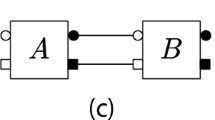Abstract
It is known that random quantum channels exhibit significant violations of multiplicativity of maximum output p-norms for any p > 1. In this work, we show that a weaker variant of multiplicativity nevertheless holds for these channels. For any constant p > 1, given a random quantum channel \({\mathcal{N}}\) (i.e. a channel whose Stinespring representation corresponds to a random subspace S), we show that with high probability the maximum output p-norm of \({\mathcal{N}^{\otimes n}}\) decays exponentially with n. The proof is based on relaxing the maximum output ∞-norm of \({\mathcal{N}}\) to the operator norm of the partial transpose of the projector onto S, then calculating upper bounds on this quantity using ideas from random matrix theory.
Similar content being viewed by others
References
Adrianov, N.: An analog of the Harer-Zagier formula for unicellular bicolored maps. Funct. Anal. Appl. 31(3), (1997)
Amosov G., Holevo A.: On the multiplicativity conjecture for quantum channels. Theor. Probab. Appl. 47, 143146 (2002)
Amosov, G., Holevo, A., Werner, R.: On some additivity problems in quantum information theory. http://arxiv.org/abs/math-ph/0003002v2, 2000
Aubrun, G.: Partial transposition of random states and non-centered semicircular distributions. http://arxiv.org/abs/1011.0275v3 [math.PR], 2012
Aubrun G., Szarek S., Werner E.: Non-additivity of Renyi entropy and Dvoretzky’s theorem. J. Math. Phys. 51, 022102 (2010)
Aubrun G., Szarek S., Werner E.: Hastings’ additivity counterexample via Dvoretzky’s theorem. Commun. Math. Phys. 305, 85–97 (2011)
Audenaert, K.: A digest on representation theory of the symmetric group, 2006. Available at http://personal.rhul.ac.uk/usah/080/QITNotes_files/Irreps_v06.pdf
Banica, T., Nechita, I.: Asymptotic eigenvalue distributions of block-transposed Wishart matrices, http://arxiv.org/abs/1105.2556v2 [math.PR], 2011
Biane P.: Some properties of crossings and partitions. Disc. Math. 175, 41–53 (1997)
Christandl M., Schuch N., Winter A.: Entanglement of the antisymmetric state. Commun. Math. Phys. 311, 397–422 (2012)
Christandl M., Schuch N., Winter A.: Highly entangled states with almost no secrecy. Phys. Rev. Lett. 104, 240405 (2010)
Collins B.: Moments and cumulants of polynomial random variables on unitary groups, the Itzykson-Zuber integral and free probability. Int. Math. Res. Not. 17, 953–982 (2003)
Collins B., Fukuda M., Nechita I.: Towards a state minimizing the output entropy of a tensor product of random quantum channels. J. Math. Phys. 53, 032203 (2012)
Collins, B., González-Guillén, C., Pérez-García, D.: Matrix product states, random matrix theory and the principle of maximum entropy. http://arxiv.org/abs/1201.6324v1 [quant-ph], 2012
Collins B., Nechita I.: Eigenvalue and entropy statistics for products of conjugate random quantum channels. Entropy 12, 1612–1631 (2010)
Collins B., Nechita I.: Random quantum channels I: Graphical calculus and the Bell state phenomenon. Commun. Math. Phys. 297(2), 345–370 (2010)
Collins B., Nechita I.: Gaussianization and eigenvalue statistics for random quantum channels (III). Ann. Appl. Prob. 21(3), 1136–1179 (2011)
Collins B., Nechita I.: Random quantum channels II: Entanglement of random subspaces, Renyi entropy estimates and additivity problems. Adv. in Math. 226(2), 1181–1201 (2011)
Collins B., Nechita I., Ye D.: The absolute positive partial transpose property for random induced states. Random Matrices. Th. Appl. 01, 1250002 (2012)
Collins B., Śniady P.: Integration with respect to the Haar measure on unitary, orthogonal and symplectic group. Commun. Math. Phys. 264, 773–795 (2006)
Cubitt T., Harrow A.W., Leung D., Montanaro A., Winter A.: Counterexamples to additivity of minimum output p-Renyi entropy for p close to 0. Commun. Math. Phys. 284, 281–290 (2008)
Grudka A., Horodecki M., Pankowski L.: Constructive counterexamples to additivity of minimum output Rényi entropy of quantum channels for all p > 2. J. Phys. A: Math. Gen. 43, 425304 (2010)
Harrow, A.: Permutations are sort of orthogonal, 2012
Harrow, A., Montanaro, A.: An efficient test for product states, with applications to quantum Merlin-Arthur games. In: Proc. 51st Annual Symp. Foundations of Computer Science, 2010, Piscatauay, NJ: IEEE, pp. 633–642, http://arxiv.org/abs/1001.0017v6 [quant-ph], 2012, Final version to be published
Hastings M.B.: Superadditivity of communication capacity using entangled inputs. Nature Physics 5, 255 (2009)
Hayden, P.: The maximal p-norm multiplicativity conjecture is false. http://arxiv.org/abs/0707.3291v1 [quant-ph], 2007, latex combined with another preprint and published in Commun. Math. Phys. 284, 263–270 (2008), ref [27]
Hayden P., Winter A.: Counterexamples to the maximal p-norm multiplicativity conjecture for all p > 1. Commun. Math. Phys. 284(1), 263–280 (2008)
Kobayashi, H., Matsumoto, K., Yamakami, T.: Quantum Merlin-Arthur proof systems: are multiple Merlins more helpful to Arthur? In: Proc. ISAAC ’03, Berlin-Heidelberg-New York: Springer, 2003, pp. 189–198
Matsumoto, K.: Some new results and applications of additivity problem of quantum channel. Poster at QIP’05 conference, 2005
Matsumoto, S., Novak, J.: Unitary matrix integrals, primitive factorizations, and Jucys-Murphy elements. In: Discrete Math. Theor. Comput. Sci., FPSAC 2010, Nancy. Disc. Math. Theor. Sci., 2010, pp. 403–412
Matsumoto, S., Novak, J.: Jucys-Murphy elements and unitary matrix integrals. To appear in International Mathematics Research Notices, available at http://arxiv.org/abs/0905.1992v3 [math. Co], 2012
Nica, A., Speicher, R.: Lectures on the combinatorics of free probability. Volume 335 of London Mathematical Society Lecture Note Series. Cambridge: Cambridge University Press, 2006
Novak J.: Jucys-Murphy elements and the unitary Weingarten function. Banach Center Publ. 89, 231–235 (2010)
Shor P.W.: Equivalence of additivity questions in quantum information theory. Commun. Math. Phys. 246(3), 453–472 (2004)
Werner, R., Holevo, A.: Counterexample to an additivity conjecture for output purity of quantum channels. http://arxiv.org/abs/quant-ph/0203003v1, 2002
Winter, A.: The maximum output p-norm of quantum channels is not multiplicative for any p > 2. http://arxiv.org/abs/0707.0402v3 [quant-ph], 2008, later included in ref. [27]
Author information
Authors and Affiliations
Corresponding author
Additional information
Communicated by M. B. Ruskai
Rights and permissions
About this article
Cite this article
Montanaro, A. Weak Multiplicativity for Random Quantum Channels. Commun. Math. Phys. 319, 535–555 (2013). https://doi.org/10.1007/s00220-013-1680-7
Received:
Accepted:
Published:
Issue Date:
DOI: https://doi.org/10.1007/s00220-013-1680-7



